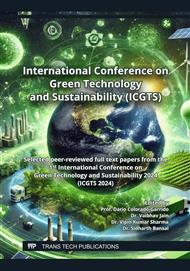p.29
p.47
p.53
p.67
p.79
p.89
p.103
p.117
p.131
Determination of Minimum Energy Consumption of an Industrial Reverse Osmosis Desalination System
Abstract:
In this work, minimum energy consumption is found for industrial Reverse Osmosis (RO) desalination system using Cerci and Gibbs free energy approaches. The RO plant uses groundwater of salinities, 800-1000 ppm and produces purified water, having zero salinity. The properties of incoming water are modelled as ideal solution of salt and water. For Cerci approach, input parameters are, salinities of incoming and outgoing water, recovery ratio. The dataset reported in literature is used and mathematical model developed in Engineering Equation Solver (EES) is validated with published results. Minimum separation work is found for incoming water, having salinities, 800-1000 ppm and recovery ratios from 0.2-0.95. In Gibbs free energy approach, input parameters are, salinity, density, molarity and temperature. A mathematical model is developed in EES, dataset reported in literature is used and model is validated with published results. In Gibbs free energy approach, minimum energy consumption is found using input parameters collected from plant, also with temperature variation, 15-55°C. The results indicate that minimum energy consumption increases with increase in salinity of incoming water, decrease in salinity of outgoing water, increase in recovery ratio and increases with increase in temperature of incoming water. Hence, temperature of incoming water may be kept low to save energy. Keywords: Reverse osmosis desalination, energy analysis, minimum energy consumption. *Corresponding author: gaurav.dst@gmail.com
Info:
Periodical:
Pages:
79-86
Citation:
Online since:
August 2025
Authors:
Price:
Сopyright:
© 2025 Trans Tech Publications Ltd. All Rights Reserved
Share:
Citation:


